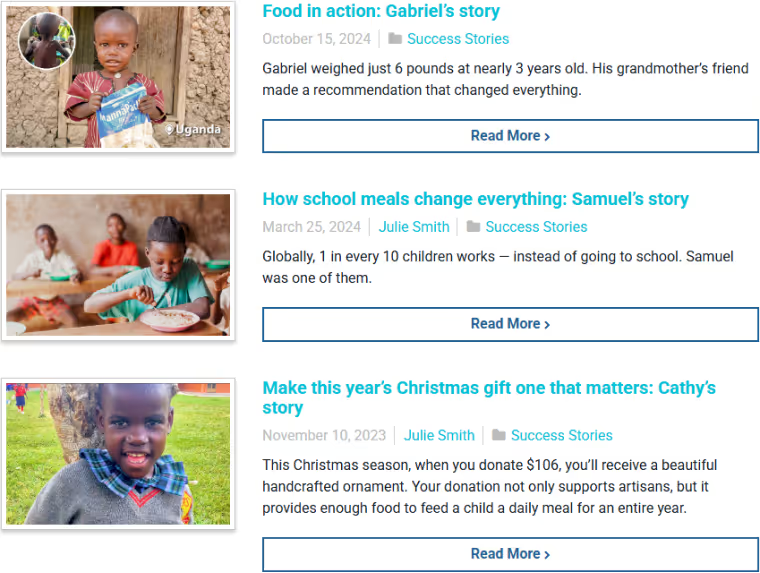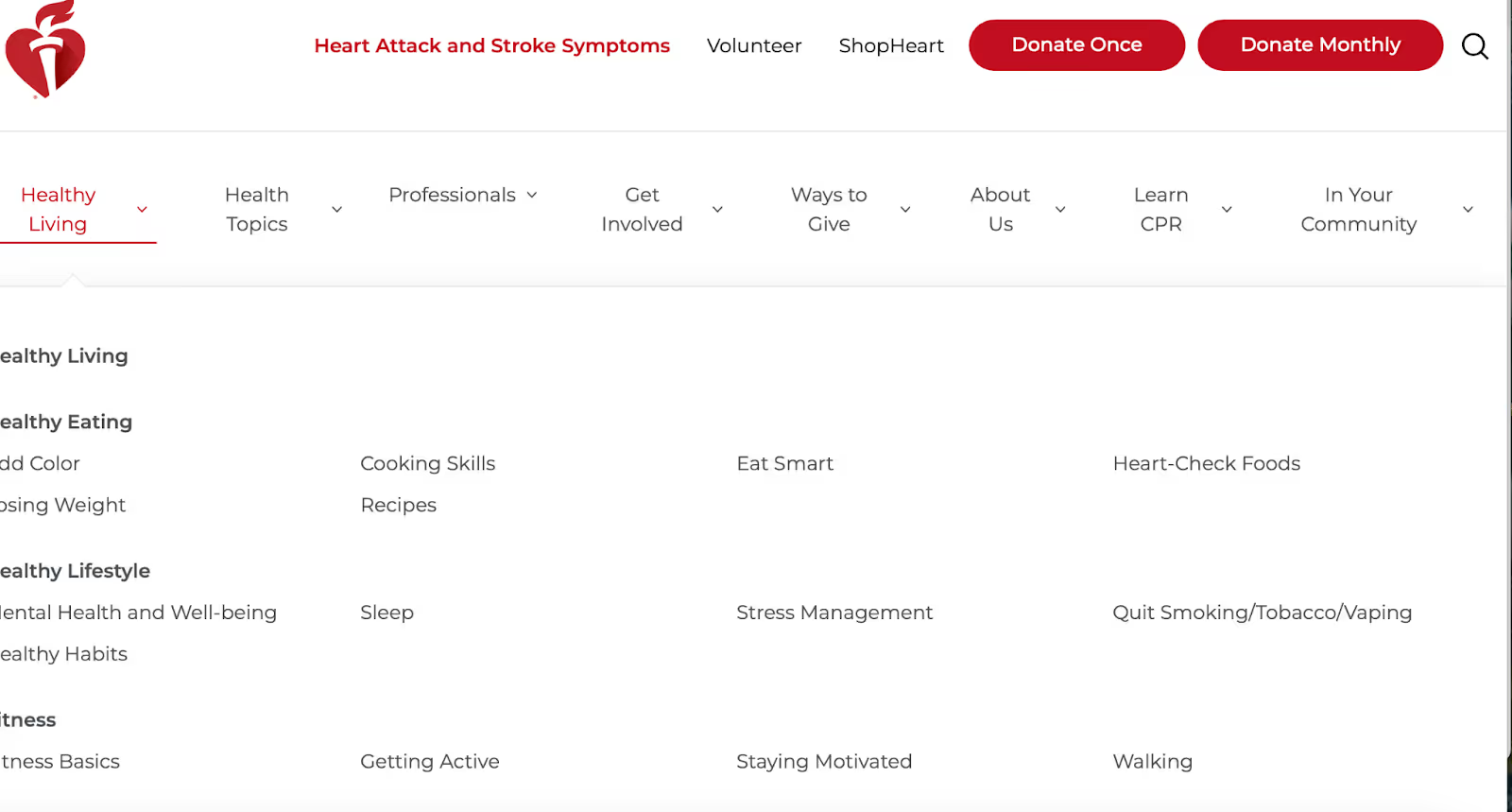Content Marketing for Nonprofits: Strategy, Templates + Examples

Categories
Publish Date
Services
Share

Ready to Tell Stories That Move People?
We help nonprofits craft narratives that inspire action, build trust, and raise more support. Let’s Bring Your Story to Life!
Content marketing isn’t just another task on your to-do list—it’s a powerful tool for nonprofits to connect, inspire, and drive action. In a world where attention is scarce, well-crafted content is how you showcase your mission, engage supporters, and turn interest into impact.
But let’s be real—creating meaningful, results-driven content takes more than good intentions. You need a clear strategy, proven templates, and real-world examples to make your efforts count. That’s exactly why we created this guide—to give you the framework and tools to create content that not only spreads your message but fuels your mission.
What Is Content Marketing for Nonprofits?
Content marketing is a strategic approach focused on creating and distributing valuable, relevant, and consistent content to attract and retain a clearly defined audience, ultimately driving desired actions.
How Content Marketing Differs for Nonprofits vs. For-Profit Businesses
While both nonprofits and for-profit businesses utilize content marketing, their objectives and approaches differ:
- Purpose and Goals:
- Nonprofits: Aim to advance a social cause or mission, using content to inspire action, educate the public, and mobilize supporters.
- For-Profits: Focus on generating revenue, with content designed to promote products or services and drive sales.
- Audience Engagement:
- Nonprofits: Engage with donors, volunteers, beneficiaries, and supporters motivated by the cause, requiring content that fosters emotional connections and community.
- For-Profits: Target customers or potential customers, emphasizing product benefits and competitive advantages.
- Content Focus:
- Nonprofits: Center on storytelling, impact reports, beneficiary experiences, and educational materials to demonstrate their mission's value.
- For-Profits: Highlight product information, industry trends, and company news to showcase expertise and market differentiation.
Examples of Nonprofit Content Types
Nonprofits can leverage various content forms to engage their audience:
- Blog Posts
- Social Media Updates
- Email Newsletters
- Videos
- Infographics
- Podcasts
- Case Studies
- White Papers
- E-books
- Webinars
Why Is Content Marketing Important for Nonprofits?
It’s about building a bridge between your nonprofit’s mission and the people who care about it. But why does it work? And why should you invest time and effort into it?
1. Builds Awareness and Trust: Transparent, impactful content, like behind-the-scenes videos or success stories, establishes your credibility and shows supporters where their contributions go.59% of donors consider trust the most important factor when donating, closely followed by connection, ease, and immediacy.
2. Inspires Action: Compelling stories motivate donors and volunteers. For example, Feeding America’s story of a single father led to a significant increase in donations.
3. Keeps Supporters Engaged: Regular content updates, such as newsletters or social media posts, ensure your audience stays connected to your cause. 55% of people who engage with nonprofits on social media end up taking some sort of action.

Explore our Best Nonprofit Marketing Campaigns 2025 article for examples of successful content strategies.
Types of Content Marketing for Nonprofits
Effective content marketing is essential for nonprofits to engage supporters, raise awareness, and drive meaningful action. By leveraging diverse content types, organizations can connect with their audience across multiple platforms. Below is a comprehensive list of content formats to consider:
1. Search Engine Optimization (SEO)
Optimize your website and blog content with relevant keywords to improve search engine rankings. This strategy increases visibility, drawing more visitors to your site and expanding your reach.
2. Email Newsletters
Maintain regular communication with supporters through email newsletters. Share success stories, highlight upcoming events, and demonstrate how donor contributions make a difference, fostering a sense of community and commitment.
3. Social Media Posts
Utilize platforms like Instagram, Facebook, TikTok, and LinkedIn to share your message through images, videos, and interactive content. For example, short TikTok videos can showcase behind-the-scenes glimpses of your work, while Instagram Stories are ideal for updates and calls to action. Visual content is particularly impactful, attracting 94% more views than text-only posts.
5. eBooks and Educational Content
Develop comprehensive resources that educate your audience about complex issues related to your mission. Offering in-depth content positions your organization as an authority and provides valuable information to your supporters.
6. Podcasts
Launch a podcast series to discuss topics pertinent to your cause. Featuring interviews with experts, stories from beneficiaries, or insights from your team can engage listeners and build a loyal following.
7. Live Webinars
Host live webinars to provide interactive educational experiences. These sessions allow real-time engagement, fostering deeper connections and providing a platform for discussing important issues.
8. Infographics
Create visually appealing infographics to present data and statistics in an easily digestible format. This approach simplifies complex information, making it accessible and shareable.
9. Case Studies
Develop case studies that showcase the impact of your programs. Highlighting specific success stories provides tangible evidence of your organization's effectiveness and inspires trust among supporters.
10. Videos
Produce engaging videos that tell your organization's story, feature testimonials, or provide updates on projects. Video content is highly engaging and can significantly boost awareness and support.
Read our comprehensive guide on video marketing for nonprofits.
11. User-Generated Content (UGC)
Encourage your supporters to create and share content related to your cause. This could include testimonials, personal stories, photos, or videos showcasing their involvement. UGC fosters a sense of community and authenticity, as it allows supporters to voice their experiences and connections to your mission.
12. Virtual Events and Webinars
Host online events such as workshops, panel discussions, or Q&A sessions to engage with your audience in real-time. Virtual events break geographical barriers, allowing you to reach a wider audience. They provide an interactive platform to discuss important topics, showcase expertise, and foster a sense of community among participants.
13. Annual Reports and Impact Reports
Develop comprehensive reports that detail your organization's activities, financial health, and impact over the year. These documents provide transparency, build trust with stakeholders, and serve as valuable tools for demonstrating accountability and effectiveness. Incorporate visuals, infographics, and compelling narratives to make the reports engaging and accessible.
14. Infographics and Data Visualizations
Create visual representations of data to simplify complex information and highlight key statistics. Infographics are highly shareable and can effectively communicate your organization's impact, the significance of your cause, or steps supporters can take to get involved. Utilizing infographics can enhance understanding and retention of information among your audience.
15. Podcasts
Launch a podcast series to delve into topics related to your mission. Podcasts offer a platform for in-depth discussions, interviews with experts, and storytelling that can reach supporters during their commute, workouts, or leisure time. This format allows for a personal touch, as listeners can hear directly from your team, beneficiaries, or thought leaders in your field.
16. Live Streaming
Utilize platforms like Facebook Live, Instagram Live, or YouTube Live to broadcast events, behind-the-scenes content, or real-time updates. Live streaming fosters immediacy and authenticity, allowing supporters to engage with your organization spontaneously. It also provides an opportunity for real-time interaction through comments and questions, enhancing engagement and community building.
17. E-books and Whitepapers
Develop in-depth resources that provide comprehensive insights into issues related to your cause. E-books and whitepapers can establish your organization as a thought leader and serve as valuable educational tools for your audience. Offering these resources can also aid in building your email list, as supporters may provide contact information in exchange for access.
18. Quizzes and Interactive Content
Design interactive content such as quizzes, surveys, or interactive infographics to engage your audience actively. This type of content can educate supporters about your cause, assess their knowledge, or gather valuable feedback. Interactive content often leads to higher engagement rates and can be a fun way to involve your audience in your mission.
Integrating Digital and Non-Digital Efforts
The most effective strategies combine digital and non-digital approaches to maximize impact. For example:
- Promote a fundraising event (non-digital) with a social media campaign (digital) and follow up with an email recap for attendees.
- Create a brochure for an educational workshop and share a digital version as an eBook on your website.
The best example is the Asda Tickled Pink campaign, in collaboration with Breast Cancer Now. It effectively utilized a variety of marketing tools to integrate the offline and digital efforts to raise breast cancer awareness and funds.

Content Marketing Strategy for Nonprofits: Step-by-Step
Ready to build a strategy that works? Follow these steps:
Step 1: Define Your Goals
What do you want to achieve? Whether it’s raising donations, recruiting volunteers, or increasing event attendance, your goals will guide your content strategy. For example:
- Increase donations by 20%.
- Recruit 50 new volunteers.
- Drive attendance to an event.
Step 2: Identify Your Audience
Identify and understand the audience based on their interests, behaviours, needs, problems and engagement history.
- Young professionals might prefer Instagram reels.
- Older supporters might favor detailed email updates.
Step 3: Choose Content Formats
Align your content types with your goals. Not every format is for you, be mindful of what you actually ‘CAN’ do and create a strategy to pick out the highest impact formats for communication. The common formats are:
- Videos: Ideal for emotional storytelling and raising awareness.
- Blogs: Great for education and SEO.
- Emails: Perfect for personalized engagement.
Step 4: Build a Content Calendar
Consistency is key. Plan your content around key dates, like Giving Tuesday or awareness months, to stay consistent. Use Google Trends to identify seasonality.
Takeaway: Tools like Trello or Google Sheets can help you organize your content efforts effectively.
For tips on integrating social media into your strategy, see our Social Media for Nonprofits Guide, and download our social media content calendar template here.
Overcoming Common Challenges in Nonprofit Content Marketing
Content marketing can feel overwhelming, especially when you have competing priorities. Here’s how to tackle common hurdles:
Challenge 1: Limited Budget
When every dollar counts, finding cost-effective ways to produce and distribute content is essential. The good news? Many tools can help you create high-quality materials without breaking the bank.
Leverage free or low-cost tools to streamline your content creation and management:
- Canva for graphic design and social media templates.
- Mailchimp for email marketing campaigns.
- Hootsuite for social media scheduling and performance tracking.
- ChatGPT for generating engaging content, brainstorming ideas, and refining your messaging.
Additionally, repurpose existing content to maximize its reach. For example, transform a blog post into a series of social media posts or an infographic for newsletters.
Real-World Budget Allocation Example:
Consider a small nonprofit with an annual operating budget of $100,000. Allocating 10%, a common practice—would designate $10,000 for marketing and content efforts. Here's a potential breakdown:
- Personnel Costs: $4,000
- Part-time content creator or stipend for a dedicated volunteer.
- Content Creation Tools: $1,500
- Subscriptions to platforms like Canva for design and Mailchimp for email campaigns.
- Social Media Advertising: $2,000
- Targeted ads to expand reach and engagement.
- Email Marketing Platform: $500
- Investing in a reliable service to maintain donor communication.
- Miscellaneous Expenses: $2,000
- Printing materials, promotional items, or unforeseen costs.
This structured approach ensures that each dollar is purposefully spent to advance the organization's mission.
Pro Tip:
Leverage Google Ad Grants, which offer eligible nonprofits up to $10,000 per month in free Google Ads. This can significantly amplify your online presence without impacting your budget. Additionally, regularly analyze your marketing efforts to identify high-performing strategies, allowing you to allocate resources more effectively.
For a comprehensive guide on budgeting for marketing and branding, refer to our Nonprofit Budget Plan guide.
Pro Tip: Use analytics tools to identify top-performing content, then adapt it for new audiences or formats.
Challenge 2: Reaching the Right Audience
Connecting with the right people—those who are passionate about your mission—is crucial but often tricky. Casting a wide net without a clear strategy can waste time and resources.
Focus your efforts by using targeted marketing tools and collaborative strategies:
- Social Media Targeting Tools: Platforms like Facebook Audience Insights help you refine your messaging by analyzing demographics, behaviors, and interests.
- Collaborate with Local Influencers: Partner with micro-influencers who have engaged, niche followings aligned with your cause. Their authentic advocacy can amplify your message and attract new supporters.
Pro Tip: Narrowing your focus ensures your message resonates with the people who are most likely to act.
Challenge 3: Measuring Success
Without clear metrics, it’s hard to know whether your content is driving impact. Many nonprofits struggle to track performance effectively, but simple tools can make this process manageable.
Start by identifying the key performance indicators (KPIs) that align with your goals, such as:
- Website traffic.
- Email open and click-through rates.
- Social media engagement (likes, shares, comments).
- Donation conversions.
Use free tools like Google Analytics to monitor website activity or platform-specific insights (e.g., Instagram Insights) to measure social media performance. Regularly reviewing these metrics allows you to refine your strategy and focus on what works.
Pro Tip: Set up automated reports to save time and ensure consistent tracking.
Challenge 4: Too Busy with Other Nonprofit Activities to Prioritize Marketing
For nonprofits juggling limited staff and numerous responsibilities, finding time for content marketing can seem impossible.
Consider outsourcing your marketing efforts to professionals passionate about nonprofits. A dedicated marketing agency for nonprofits, like Fifty & Fifty, can develop comprehensive strategies while reducing the workload for your team. They can handle everything from content creation to performance analysis, allowing you to focus on your core mission.
Pro Tip: Sometimes, letting experts take the reins ensures your marketing efforts are consistent, impactful, and aligned with your goals.
Content Marketing Best Practices for Nonprofits
Crafting impactful content requires more than just creativity, it demands strategy, authenticity, and consistency. By following these best practices, your nonprofit can create campaigns that inspire action, build trust, and foster long-term connections.
1. Use Storytelling to Build Emotional Connections
Stories humanize your mission and demonstrate the real-life impact of your work. Instead of focusing solely on numbers, highlight personal narratives that resonate with your audience. According to the Stanford Graduate School of Business, stories are remembered up to 22 times more than facts alone. Data is important, but it’s the human stories behind the numbers that leave lasting impressions.
Example: Instead of saying, “We provided 1,000 meals this month,” tell the story of a single parent who no longer has to worry about feeding their family because of your efforts. These stories make your mission relatable and inspire supporters to act.
2. Leverage Visual Content
Visuals grab attention, simplify complex messages, and drive engagement. Photos, videos, and infographics help convey your mission in a way that words alone cannot.
Visual content increases viewer retention. For example, a video of volunteers delivering meals can show the direct impact of donor contributions.
Pro Tip: Use free tools like Canva to create professional-looking graphics and animations.
3. Stay Consistent Across Platforms
Consistency in branding, tone, and visuals builds trust and reinforces your nonprofit’s identity. Ensure your content, whether it’s a blog post, social media update, or email, aligns with your organization’s core values and mission.
Download our Donor-Centered Content Marketing Checklist to keep your campaigns on track.
4. Be Strategic and Authentic
To maximize impact, focus on what works and stay authentic in your messaging. Here’s what to do, and avoid:
5. Repurpose Content Across Channels
CategoryActionDescriptionDOSet Clear GoalsIdentify key performance indicators (KPIs) like donor retention rates or cost per donor acquisition to measure success.Highlight Tangible ImpactShow how contributions make a difference (e.g., “$50 donation provides 10 meals for the homeless”).Prioritize AccessibilityEnsure content is mobile-friendly, uses alt text for images, and features high-contrast designs. Include translated materials to reach diverse audiences.Pay Attention to TrendsFollow emerging trends, like TikTok campaigns, to engage younger donors effectively.DON’TSpread Yourself Too ThinFocus on the most effective platforms for your audience. OverpromiseAvoid creating unrealistic expectations and maintain transparency about goals to build trust.Use JargonUse simple, accessible language to ensure your message resonates with a wide audience.
Examples of Successful Nonprofit Content Marketing Campaigns
1. Samaritan’s Purse "How-To" Video Series
Samaritan’s Purse, through its Operation Christmas Child initiative, has effectively utilized engaging content to mobilize supporters. A notable example is their "How to Pack a Shoebox" video, designed to educate and inspire participants in a humorous and accessible manner.
The Strategy:
The "How to Pack a Shoebox" videos provide step-by-step instructions on assembling gift-filled shoeboxes for children in need. By incorporating humor and relatable scenarios, the video makes the packing process enjoyable and memorable, encouraging more individuals and families to participate.
Why This Approach Works:
- Educational Content: The video demystifies the packing process, making it straightforward for newcomers to get involved.
- Entertainment Value: Humorous elements capture viewers' attention, increasing the likelihood of sharing and wider dissemination.
- Enhanced Visibility: Engaging content encourages social sharing, broadening the campaign's reach and attracting new supporters.

2. ICRC Syria Anniversary
The International Committee of the Red Cross (ICRC) in Syria, a leading humanitarian organization committed to providing critical aid and protection in conflict zones.
Strategy:
In commemorating the anniversary of its operations in Syria, the ICRC sought to amplify its mission and impact through a strategic content marketing campaign. The objective was to humanize its work, share compelling stories from the ground, and engage a global audience to garner further support and drive donor engagement.
Why This Approach Works:
- Storytelling Through Multiple Formats:
Fifty &Fifty developed a comprehensive content strategy that leveraged a mix of video documentaries, written narratives, and powerful imagery. By showcasing personal stories and behind-the-scenes insights, the campaign brought the realities of humanitarian work in Syria to life. - Integrated Digital Channels:
Content was distributed across multiple digital platforms including the ICRC website, social media channels, and press releases. This ensured a consistent narrative and maximized reach, engaging audiences across different touchpoints. - Data-Driven Messaging:
By incorporating impact data and real-life testimonials, the campaign not only highlighted the urgent needs on the ground but also underscored the positive outcomes achieved through ICRC interventions. This blend of qualitative and quantitative content helped build trust and credibility with donors and stakeholders.
3. Feed My Starving Children
Feed My Starving Children (FMSC) effectively utilizes content marketing to engage supporters and demonstrate the impact of their contributions. A key component of their strategy is the dissemination of newsletters featuring personal stories of children whose lives have been transformed through their programs.
The Strategy:
FMSC's weekly newsletters provide subscribers with heartfelt narratives and updates from their blog, highlighting individual success stories. These stories showcase the tangible results of donations and volunteer efforts, fostering a deeper connection between supporters and the organization's mission.
Why This Approach Works:
- Personalization: Sharing individual stories humanizes the impact of FMSC's work, allowing supporters to see the direct effect of their contributions on real lives.
- Consistency: Regular weekly updates keep FMSC's mission at the forefront of supporters' minds, maintaining engagement and encouraging ongoing involvement.
- Transparency: By providing concrete examples of how donations are utilized, FMSC builds trust and credibility with its audience.

4. American Heart Association’s "Healthy for Good" Campaign
The "Healthy for Good" campaign by the American Heart Association (AHA) encourages individuals to adopt sustainable habits for a healthier lifestyle. The initiative focuses on four pillars: Eat Smart, Move More, Be Well, and Add Color. By addressing nutrition, physical activity, mental well-being, and balanced diets, the campaign empowers people to take small, manageable steps toward better health.
The Strategy:
- Educational Content: The campaign provides resources on healthy living, including recipes, stress management tips, and exercise routines.
- Video Series: Short, engaging videos offer practical guidance on building lasting healthy habits.
- Visual Resources: Infographics and shareable content simplify complex health information, making it accessible to a broad audience.
Why It Worked:
- Multi-Platform Presence: The campaign utilized social media and video content to reach a diverse audience effectively.
- Accessible Resources: Practical tips and engaging visuals made healthy habits easy to understand and implement.
- Consistency: The messaging and visuals across platforms reinforced the campaign's objectives, fostering trust and credibility.


For more case studies, see our Best Nonprofit Marketing Campaigns 2025.
Content marketing for nonprofits isn’t just about creating content, it’s about telling stories, inspiring action, and building lasting connections. By using storytelling, leveraging visuals, and sticking to a clear strategy, your nonprofit can amplify its mission and achieve measurable results.
Have a project or idea?
We believe in the hard work people are doing to address the world's most pressing problems. Every day, our agency fights to turn visions of social change into concrete realities.





